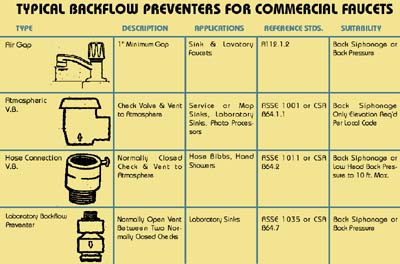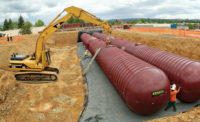
Some years ago, I was on a business trip to Germany and had a room on the top floor of a hotel. In the early morning, I was amazed to hear a loud sucking sound coming from the bath. There was no water pressure at the fixtures and the sucking sound came from a fitting on the wall over the shower.
Each shower was equipped with the usual European hand shower, and rather than have a backflow preventer on each shower hose, the building had vacuum breakers on the top of each riser. It appeared that a drop in water pressure in the area was a regular occurrence and the water pressure returned after about an hour.
While this approach to backflow protection seemed effective, it would not meet U. S. code requirements, which mandate that every outlet fitting have backflow protection.
That's right; every fitting outlet must be protected. Whether it's due to a loss of pumping pressure, a broken water main, a power failure or a major fire, loss of water pressure is a relatively frequent occurrence in most cities. As a result, plumbing codes mandate that every faucet outlet have backflow protection and cite the applicable standards for each type of outlet. The primary standards for faucets are ASME A112.18.1 and CSA B125. To make things seemingly more complicated, these standards mandate that fittings be protected by an air gap in accordance with ASME A 112.1. 2 or by backflow protection devices described in either ASME A112.18.3 or the CSA B64. The individual devices described in these standards are covered by standards created by ASSE or sub-sections of CSA B64. One or both of these standards are referenced in all U.S. and Canadian plumbing codes.
Before you throw up your hands over the alphabet soup chain of references, the codes have found a simple solution. The codes describe the various backflow devices and list the ASSE or CSA standard to which a device must comply. The codes also include the applicable dimensions required for faucets protected by an air gap.
Table 1 summarizes the various types of faucets and typical protective devices used for commercial facilities. The term "commercial facilities" can encompass a wide range of buildings, such as offices, retail, educational, recreational and hospitality, which require similar plumbing fixtures.
Public Lavatories
Whether manual or electronic faucets are utilized, all faucets on sinks and lavatories are required to have a minimum air gap of one inch between the faucet outlet and the flood level of the fixture. To allow for mounting recesses, or elevated rims on sinks, most faucet manufacturers offer fittings with 1-1/4" to 2" or more between the mounting base and the spout outlet.Service Sinks
The second most frequent fitting found in commercial buildings is the mop or service sink fitting. These fittings generally have a hose threaded outlet to permit attachment of a short hose and are generally protected by an atmospheric vacuum breaker (AVB) covered by ASSE 1001. These devices must be mounted a minimum of 6" above the flood level of a fixture; however, many codes prescribe higher elevations for this type of device.Hose Bibbs
Hose bibbs must be protected either by an AVB or a Hose Connection Vacuum Breaker. These later devices are covered by ASSE 1011 and are normally required by the codes to be non-removable. Typically, these devices are equipped with a locking feature such as a break-off screw that prevents their removal after installation.Shower Rooms
The normal shower head installation obviously provides a large air gap, and further protection is not required. However, under the requirements of the Americans with Disabilities Act, handicap showers must be provided in all public facilities. For new and existing facilities, a certain percentage of showers must be made accessible by the installation of a hose-connected hand shower. ASSE 1014 covers the backflow protective requirements for hand showers, and atmospheric vacuum breakers or a hose connection vacuum breaker are normally installed at the hose inlet connections.Laboratory Facilities
Medical and other professional laboratory facilities require special fittings and are beyond the scope of this article. We should, however, cover the fittings used in chemistry classrooms of high schools and colleges. Classroom lab sinks are generally fitted with cold water fittings with high rise spouts with barbed outlets for hose connections. These high rise spouts should be equipped either with an AVB or a unique laboratory outlet vacuum breaker covered by ASSE 1035.Special Installation Considerations
All atmospheric vacuum breakers have vent ports that are designed to admit air to relieve vacuum conditions in the system. These same ports can be subject to leakage of water, particularly when opening or closing the supply valve. For this reason, these devices should always be installed in locations where this spillage will not create a problem.
Vacuum breakers should always be installed after the last shutoff and not be under continuous pressure. Devices of this type, if installed under continuous pressure, can be subject to sticking of the soft-seated check valve in a closed position and are therefore intended for a maximum of 12 hours under pressure.
Hazard Levels
The codes and standards recognize two levels of backflow hazard. Low hazard exists where there is the potential for backflow of polluted water. Pollution is that which is objectionable due to taste, appearance or odor, but that would not cause illness.
Liquids that are considered contaminated and are toxic or can cause illness are viewed as presenting a high hazard. The majority of potential backflow substances can cause serious illness or death (involving chemicals, pathogens, sewage and other waste), and are therefore viewed as presenting a high hazard.
